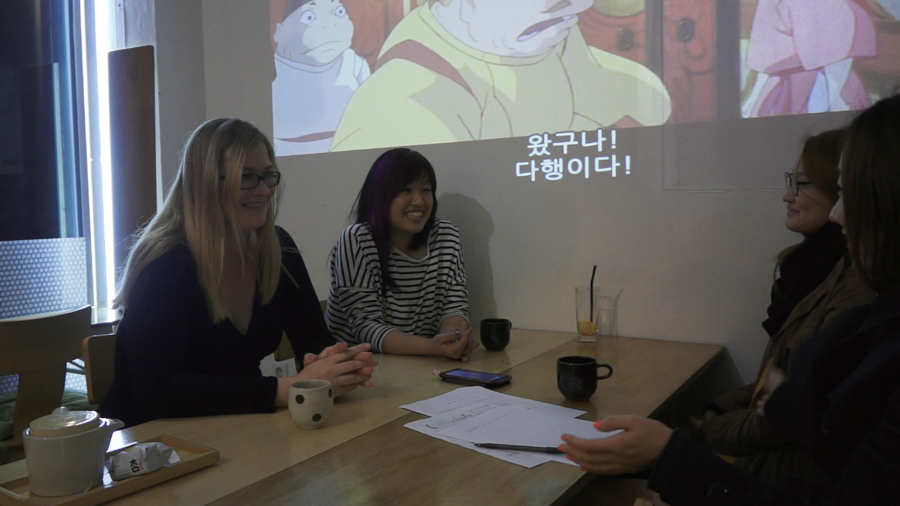June 12, 2014
Today we will be talking with Myra, an animation editor, and Misty, a storyboard artist at Walt Disney Animation Studio. We’ll talk about what they are doing and animation industries in the US. Sae Hyoun, a Korean animator, will be joining our conversation.
C.A.N. (C): Could you tell me a little bit about yourself?
Misty (M): Hi, my name is Misty. I studied Character Animation at CalArts, and graduated in 2010. After finishing the program, I did my first internship at Disney Consumer Products as a Character Artist. A few months following, I went to Disney Feature Animation as a storyboard apprentice, and was there for 6 months from 2011 to 2012. After my training, I was asked if I wanted to help storyboard on an upcoming series that would premiere on the Disney Channel called “Sofia the First.” I have been there ever since.
Myra (My): Hi, I’m Myra. I am an animation picture editor and I’m currently working in pre-production at Disney Television Animation Studios on “Sofia the First”. I majored in Graphic Design at San Jose State University and Cal States Northridge University and graduated with a Bachelor in 1997. That same year, I started my first animation job at Sony Pictures Television and I’ve been working in the animation industry ever since. Throughout the years I have worked in the editorial department in both pre-production and post-production at various television animation companies like Warner Bros., Cartoon Network, and Fox working from project to project.
C: Could you tell me about the company atmosphere of Disney comparing with other companies?
My: I think that Disney has a family-like atmosphere for artists. Everyone works well together. I enjoy spending time with my co-workers at the office and we also spend time together outside of work. But this isn’t just true at Disney, every animation studio I’ve work at has a friendly, family-like atmosphere.
Working in TV animation has really been a positive working experience for me overall.
C: Do you and colleagues work in one studio?
My: Yes. Ideally, that’s how it should work. Most of us really enjoy what we do and there is a lot of camaraderie. That’s why I enjoy working in TV animation.
C: So you said you are making “Sofia the First,” Disney TV animation series. How many are animators involved in that animation series?
Sae Hyoun (S): They actually don’t know. Because they are making a storyboard and sending it to other countries like Korea.
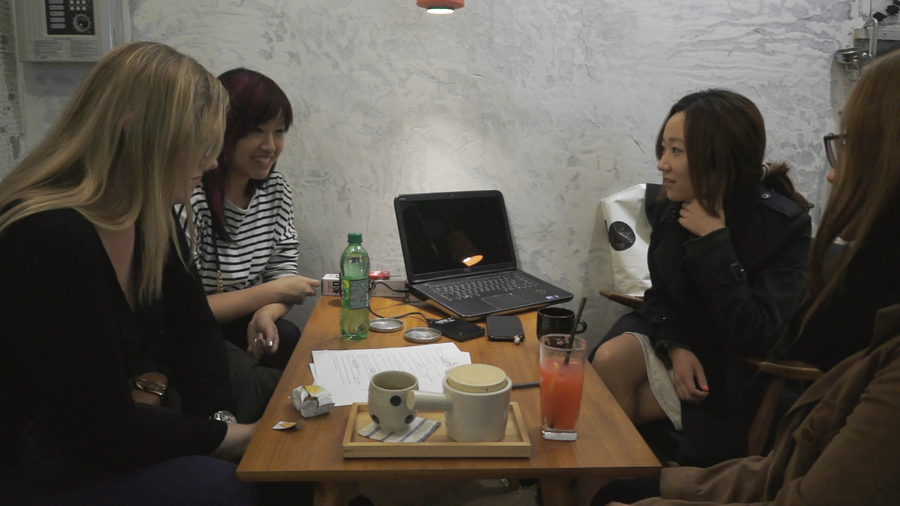
M: Yes, all the animation for Sofia is done in Korea. They help provide the animation, rigging and modeling the characters, and build all the backgrounds for the show. In America, we draw the storyboards, and designs, and send them overseas.
My: There are many facets to pre-production of an animated episode. In The U.S., the writers script out stories then storyboard artists like Misty draw pictures to illustrate the action described in the scripts, working under the supervision of the show director. Then those pictures come to me, and I edit those pictures together along with the voice recordings from our actors. Once the director is happy with the cut of the show I’ve made, all that is then sent to Korea, where they do the animation, then send it back to us for final editing.
C: Regarding the storyboard team, how many artists are there?
M: There are about twelve to fourteen storyboard artists, three revisionists who fix some of the drawings according to what the director’s vision is , two pre-production editors, and two directors. It’s a pretty big crew.
My: And there are the other artists including backgrounders, character designers, prop designers, and color stylists. It’s very collaborative.
C: Regarding character design or story making, does only one artist design or make a story, or is it also collaborative?
My: It’s definitely collaborative, there’s a team of writers, and a team of artists. We also have a lot of executives who have their ideas of what they want and goals what kind of show they have.
M: Our director can make changes as well, along with the notes the executives give us regarding the story. If they don’t like something, we have to change it.
My: On our show writers write the script and then artists work off of that, but on some other shows the writers and storyboard artists collaborate together on the story and dialogue.
C: How about character design?
M: We only have one character designer for our show.
C: It seems to be very complex process.
My: Yes, a lot of people have to work together to make one product.
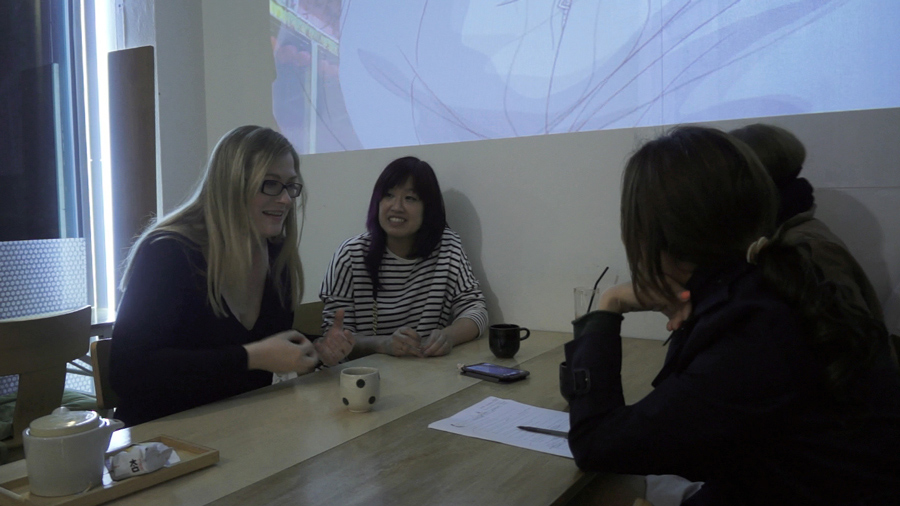
C: Who is the main target audience for your show, “Sofia the First”?
M: Preschool children, most particularly girls, and their mothers. But some boys like it, too!
C: When you set up a target audience. Do you usually research on the audience tastes?
M, My: Oh Yes. Definitely.
M: Disney does a lot of research. Before even the concept of an episode gets pushed, we make a story book, almost like a picture book, to show preschool age children in a classroom. The researchers then go to that class, show pictures and read the story. If kids don’t like some parts, for instance they get too scared, we will change the story.
My: Disney does do research… but it is not part of our job.
C: So it’s more like a consumer-driven design process.
My: Some shows in the industry do create programs to mainly headline products and others through the popularity of the show, will create products featuring the characters. But at Disney the idea is definitely to make a great show that our audience will love, that’s the top priority.
C: What is the working process like and how is it different from when you work independently or as a small group?
M: On Sofia, you have to collaborate, work with other people and work with their styles and everything to make it work as a whole. You still have a little bit of your independence… If you want show your own voice, then you have to have the balance of collaborating with others, and delivering what the director wants.
C: How about you, Myra?
My: When you are part on a show like this, my job is to work with others and create the product that the people at the top want, hopefully while getting a chance to put my stamp on it, too. I get to make a lot of choices and have some creative freedom but ultimately it will be decided by the producer and director which I closely work with. Basically I’m like the driver with someone telling me where they want to go, but there are many paths to get there so it’s a matter of what routes we take, and as long as we end up at the place where the director wants to go.
C: Okay, sometimes it may be sometimes hard to hide your individuality…
S: Yes, Disney is quite a big company. So if you want go to Disney you have to make Disney style, not your own style.
M: That is true. For me, my natural style is more Disney. It could be because I drew a lot of Disney characters growing up. For our show, they like a certain style, the old Disney traditional look.
My: Sofia does embrace that traditional style but other Disney shows do branch out into non-traditional styles, shows like Fish Hooks, Mickey Shorts, and many others all have different, unique looks.
C: You mentioned about Disney’s strategy including consumer research, testing, and systematic process. Is there any other element that led to success of Disney?
M: I think the important thing is to catch the emotion of the audience and the feeling. On our show, they want kids to be able to relate to it, with their own lives. So when they watch the show, they would think “hey, that’s me. I’ve been through that.” So when making Sofia, they really try to make it feel real, authentic and sincere.
My: For Sofia the First, the stories go in a little deeper emotionally than some other preschool shows, they really want their audience to feel something.
M: Compared to other companies, Disney seems to care deeply about how the audience feels, which could go along with their high reputation for delivering quality content. If anything goes wrong, parents could get upset, and that would be a big deal. Disney tends to pull back, to make things more safe for viewers.
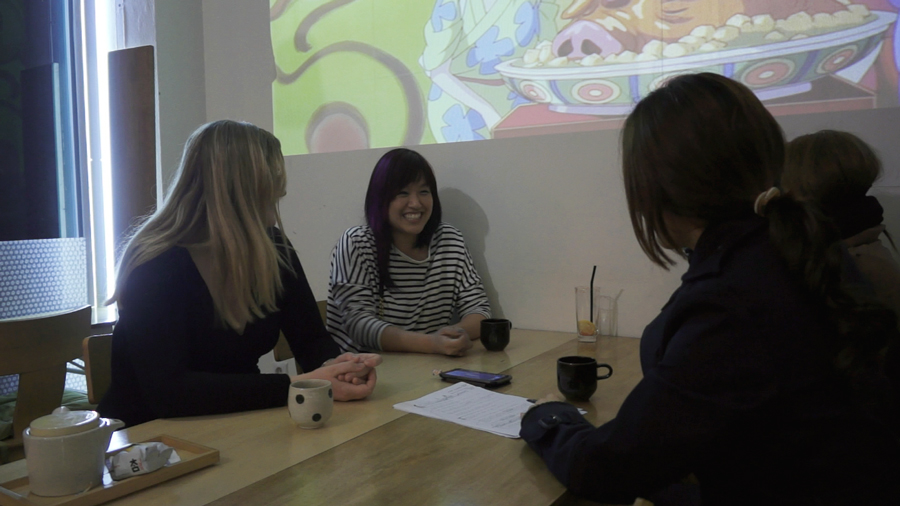
C: Why do you think Disney got a great popularity worldwide?
My: It may be due to the international marketing team. As for programming, shows are dub into multiple languages. I do believe Disney also have live action shows to little kids. That popularity also goes into international. They actually make the same show in another country with different characters.
C: Oh really?
My: Yes. They make their own versions of the characters. If there is an English show that is popular, they may make it with the same script but recast it with actors from whatever country they want to air it in, and doing things like that helps Disney appeal to kids around the world.
C: I have a question for you Sae Hyoun. You said that the animation industry in Korea is small that is a problem for animators.
S: I don’t think it is small, it is kind of big. But many of them are not developing their own shows. Only in case they develop them, most of them are for preschool. Many Koreans think animation is just for kids.
C: So comparing with the US and Japan who have relatively large animation industries, which country is closer to Korea?
S: Um, I think it’s kind of mixed. Not even close to any of them… since Korea brings works both from Japan and the US.
C: I see. I noticed that animation industry is going down because of the rise of new media and game industry. Especially in Korea where the market is pretty small, as a new industry rises, an old one tends to decline. How about animation industry in the US?
M: Also more and more jobs in animation are going overseas. Two weeks ago, Dreamworks launched a huge project in China. They will make a bunch of feature films such as Kung Fu Panda 3. They are also making another Feature in India… So if they do well, jobs in the US are going to be cut since overseas, films are so much cheaper to make. It’s really sad for us, but it’s a reality.
My: In Disney, the success or failure of movies can and do affect other industries like TV shows.
M: Like Frozen, a princess movie, people thought princess movies were dead but it did so well. They realized that these movies still have an impact.
My: So if a certain film does not work out, other related projects can be canceled or pushed out and produced in other countries… It’s a business. But because the company sponsors artists, they want them to make works in a certain way as well, in the style and quality level that they want to represent the company. It’s a big company. So I think sometimes the only way to completely have your own voice is to do your own thing and be independent.
C: But I think what they are doing makes sense in a way, since the company provides contents for a large audience.
My: You can think about animations as two things, as a product or as an art.
M: My mentor at Disney, John Ripa once told me that the story should come first and everything else will follow. So it shouldn’t be product-driven. It should be story-driven.
C: Concept of artist may vary in different fields. What is your definition of artist?
M: It is keeping your own voice, being true to yourself, and being who you are.
My: An artist uses media through various forms whether verbal, tactile or visual for self-expression.
C: Here is the last question for you. What is your goal as an artist?
M: To keep growing, and to never grow stagnant. I just want to keep being inspired and keep getting better at my craft. The journey never ends.
My: My goal is very simple, which is finding happiness through artistic self-expression, whether painting, sculpting, photography, picture editing or even the clothes I wear. Working as a picture editor, I am able to help convey the feelings and actions of a story with the timing/pacing of the placement of picture with audio. And then in my everyday life, I continue to appreciate and discover art in everything around me and be creative and inspired by it.
C: We really appreciate you speaking with CAN magazine today. I really enjoyed talking with you.
BIO
Myra Owyang
 Myra Owyang resides in sunny Southern California. As an animation editor, she’s been working in the animation industry for 17 years. When she’s not in the office, she spends time foraging for good eats, updating her photo diary and collecting Legos.
Myra Owyang resides in sunny Southern California. As an animation editor, she’s been working in the animation industry for 17 years. When she’s not in the office, she spends time foraging for good eats, updating her photo diary and collecting Legos.
Misty Marsden
 “I have been drawing since I was a child, and always dreamed of working for Disney, after I saw Beauty and the Beast. I read up on animation schools growing up, and CalArts was the one that I always held close to my heart. I applied to the animation program in 2006, and was accepted to start that Fall. I graduated from CalArts in 2010 in the character animation program, and started my first internship at Disney Consumer Products. After my time there, I decided to make a portfolio for Visual Development/painting for Disney Feature, to pursue my ultimate dream. I was accepted into their talent development program, but for Story! During an intense 6 months there and under the mentorship of John Ripa, I had to learn how to storyboard, almost completely from scratch. I learned so much from the program, and when it finished, I started my first official job in the industry at Disney Television Animation on a show called Sofia the first. I love my job, and I am around some amazing talent. My journey is just beginning, and it’s a dream come to live doing what I love.”
“I have been drawing since I was a child, and always dreamed of working for Disney, after I saw Beauty and the Beast. I read up on animation schools growing up, and CalArts was the one that I always held close to my heart. I applied to the animation program in 2006, and was accepted to start that Fall. I graduated from CalArts in 2010 in the character animation program, and started my first internship at Disney Consumer Products. After my time there, I decided to make a portfolio for Visual Development/painting for Disney Feature, to pursue my ultimate dream. I was accepted into their talent development program, but for Story! During an intense 6 months there and under the mentorship of John Ripa, I had to learn how to storyboard, almost completely from scratch. I learned so much from the program, and when it finished, I started my first official job in the industry at Disney Television Animation on a show called Sofia the first. I love my job, and I am around some amazing talent. My journey is just beginning, and it’s a dream come to live doing what I love.”
Sae Hyoun Kim
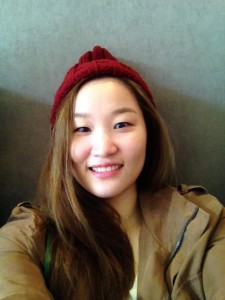 Sae graduated from California Institute of the Arts in 2010. She came back to Korea 3 years ago and since then she have worked in the animation, movie, and game industries. Now Sae works as a freelancer.
Sae graduated from California Institute of the Arts in 2010. She came back to Korea 3 years ago and since then she have worked in the animation, movie, and game industries. Now Sae works as a freelancer.
